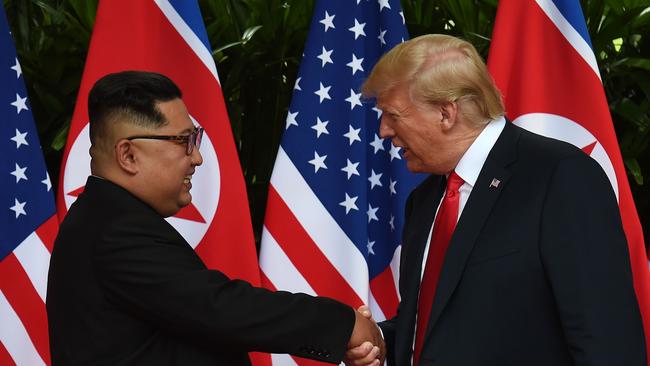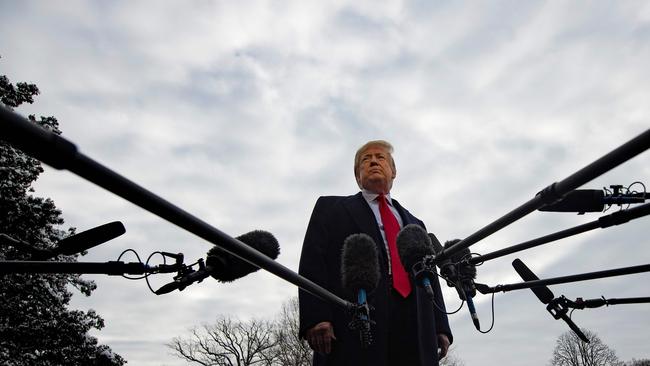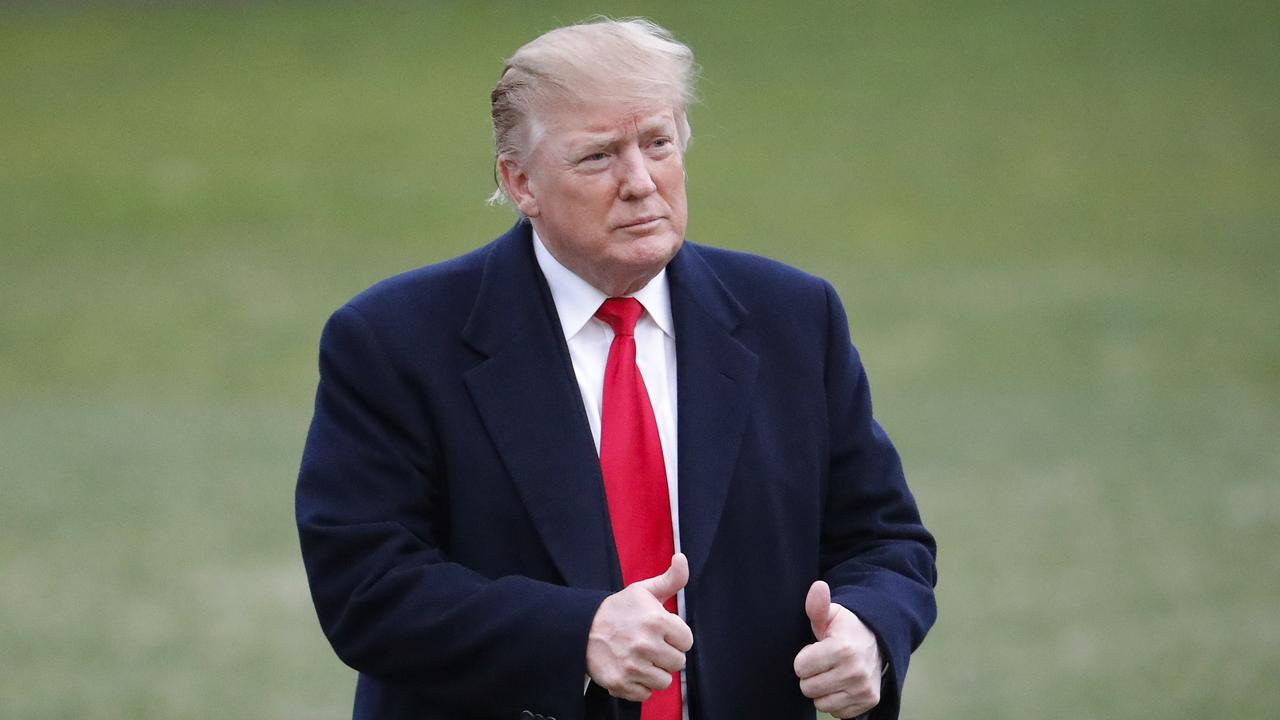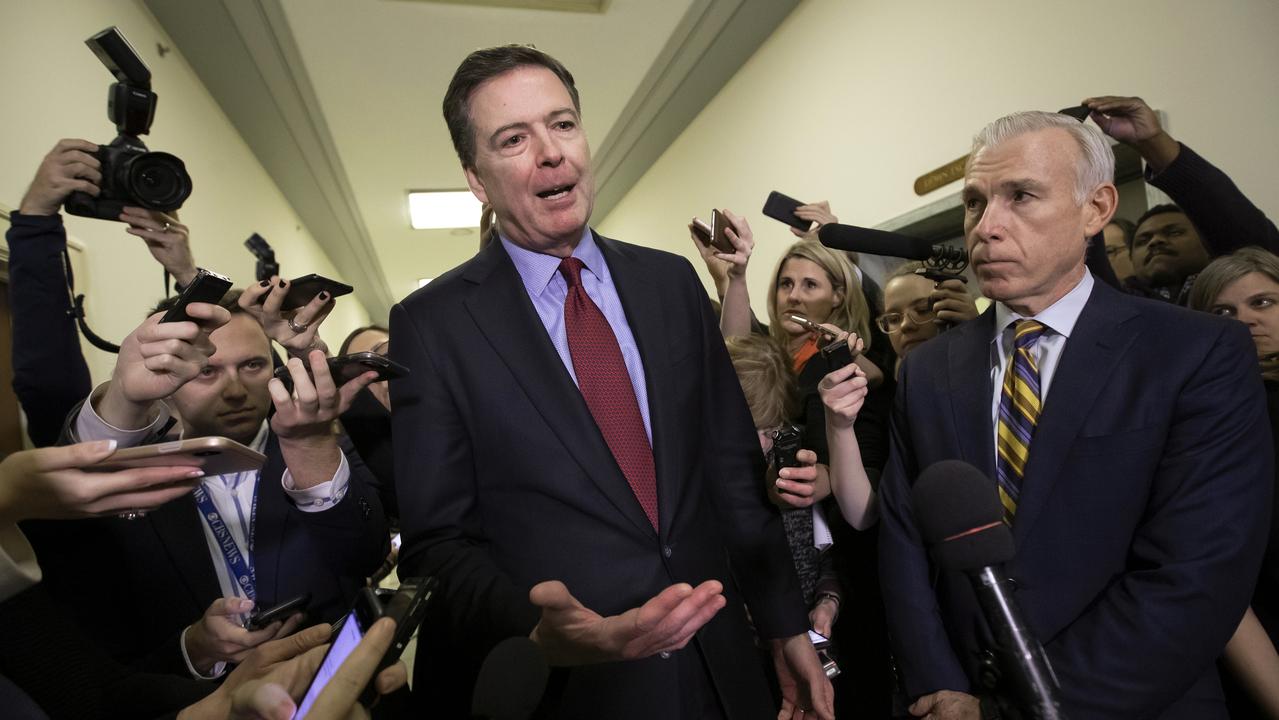Donald Trump hits the halfway mark
For all the chaos of his presidency, few could accuse Donald Trump of abandoning his election promises.

Donald Trump has reached the halfway mark of the first term of his presidency in the most inauspicious fashion.
Washington is eerily quiet, with many thousands of federal workers at home because of the continuing government shutdown, staring out at the snowstorms that have painted the capital white.
Across the country, about 800,000 federal employees across nine cabinet departments and numerous smaller agencies — more than one-third of the federal workforce — have been unpaid since late last year.
As the shutdown enters its 28th day — almost a week longer than any previous shutdown — Trump is bleeding public support. Polls show that a clear majority of Americans (53 per cent to 29 per cent) blame him rather than the Democrats for the partial shutdown that has been caused by a deadlock over the President’s demands for funding for his proposed border wall. A Gallup poll shows Trump’s approval rating has slipped from 39 per cent to 37 per cent during the shutdown, his lowest level in almost a year.
The deadlock is such that house Speaker Nancy Pelosi argues Trump should not deliver his state of the union address later this month if the government remains closed. Trump retaliated yesterday by postponing an overseas visit by the top Democrat as the feud between them over the shutdown intensified.
While most US government shutdowns in the modern era have been quickly resolved, there is no end in sight to this one. What began as a tactical manoeuvre by the President to secure funding for his border wall now threatens to have a broader impact on his presidency amid warnings that it will cruel economic growth.
On the second anniversary of his inauguration as the 45th US president, Trump is fighting battles on so many fronts that he is struggling to get voters to focus on what he says are his key achievements.

“For decades, politicians promised to secure the border, fix our trade deals, bring back our factories, get tough on China, move the Embassy to Jerusalem, make NATO pay their fair share, and so much else — only to do nothing (or worse),” Trump tweeted this week. “I am doing exactly what I pledged to do, and what I was elected to do by the citizens of our great Country. Just as I promised, I am fighting for YOU!”
Two years into his term, this tweet best summarises Trump’s approach to the presidency. Having campaigned as an agent for change, as the great disrupter who would reverse what he called the timidity and inaction of his predecessors, Trump’s bottom line is that he wants to be seen as having kept his promises. For all of the criticism levelled at the chaotic manner in which Trump conducts his presidency, few could accuse him of abandoning his election promises, or at least not trying to push them through in the face of opposition from the Democrats and, at times, the courts.
So far Trump has followed through on his promises to pass a tax reform package, including tax cuts; slash regulations that he believed were anti-business; withdraw the US from multilateral pacts such as the Trans-Pacific Partnership trade deal and the Paris climate accord; withdraw from the Iran nuclear deal; stock the Supreme Court and other courts with conservative judges; redraw the North American Free Trade Agreement and take on China over trade.
The result has been that Trump still enjoys a remarkably loyal following among Republican voters, 88 per cent of whom still approve of the job he is doing. But, as the recent mid-term elections showed, Trump has failed to expand his support base from 2016. While he has kept his most loyal supporters, especially in rural America, Trump has lost ground in the suburbs and especially in traditional Democrat states such as Pennsylvania and Wisconsin that voted for him in 2016.
Unless Trump can expand — not simply defend — his support base in the next two years, he is likely to lose in 2020. But building his base will be tough. The government shutdown is an example of the new Washington Trump must deal with after the Democrats regained control of the House of Representatives. Veteran Democrat Pelosi, who is Speaker for the second time, has shown she is willing to use her numbers to isolate and attack the President.
Given that the two sides cannot even agree on a spending bill to keep the government open, it’s hard to see how Trump can win Democrat support to implement his agenda in the second half of his term. It is clear that for all of his achievements in his first two years, Trump did not act fast enough to ram through his agenda while he had the rare luxury of a Republican majority in both houses.
The prospects of Trump achieving any substantial legislative reform — including his promised infrastructure reform or a second chance at repealing the Affordable Care Act, dubbed Obamacare — appear to be remote at best.
Many Republicans privately concede that Trump also moved too slowly on his signature promise of building a wall along the US-Mexico border as part of his promised crackdown on illegal immigration.

When Republicans controlled both houses of congress, the President was able to win approval for only $US1.6 billion in funding for the wall — which the Department of Homeland Security says will cost $US21.6bn ($30bn). Now, with the Democrats in control of the house, he wants approval for $US5.6bn to begin construction. The result has been a government shutdown.
Trump believes he needs to build the wall at all costs to show his base that he is serious about border security, an issue that was critically important to his 2016 victory. A Pew Research Centre survey this week found support for the wall among Republican voters has jumped from 72 per cent to 82 per cent during the past year.
A Washington Post/ABC News poll this week found most Americans still oppose the wall. But it said overall support for the wall has risen from 32 per cent to 42 per cent while opposition has slipped from 63 per cent to 54 per cent.
Yet the longer the shutdown continues, the more Americans are likely to question the cost that Trump has imposed on them by demanding that any spending bill include funding for the wall.
The shutdown poses broader risks to Trump if it continues much longer. The most successful and popular aspect of his presidency — the strong US economy — is being undermined with each passing day that the government is closed. Credit ratings firm Standard & Poor’s estimates the shutdown will shave $US1.2bn off gross domestic product for each week the government is closed. JPMorgan chief executive Jamie Dimon this week cited estimates “that if (the shutdown) goes on for the whole quarter, it can reduce growth to zero”.
This promises to unsettle an already volatile Wall Street, which tumbled during Trump’s second year as president after booming throughout his first.
Beyond the shutdown, the defining moment of Trump’s third year in office may be out of his hands. The report by special counsel Robert Mueller could come down as early as next month, revealing whether there was collusion between the Trump camp and Russia and the more explosive question of whether Trump tried to obstruct justice.
We already know from the blizzard of Mueller indictments that Russia actively sought to interfere in the 2016 election in favour of Trump. On the question of collusion with Russia, any finding of collusion would affect Trump directly only if Mueller could prove he knew about it. No public evidence has yet come to light to indicate that Trump was involved in collusion.
The greater and more damaging question is whether Mueller concludes that Trump’s behaviour in his dealings with then FBI chief James Comey and his subsequent sacking of Comey amounted to an attempt to obstruct justice. Even if Mueller does conclude this, he is unlikely to try to indict the President, leaving it up to congress to decide what to do.
Given that Republicans hold a comfortable 53-47 majority in the Senate, Mueller’s revelations would need to be truly explosive to persuade enough of them to cross the Senate floor to obtain the two-thirds majority vote needed to impeach him and remove him from office. Therefore, the real danger that the Mueller report poses for Trump is the damage it could do to his popularity and his prospects for re-election.
After two years as president, Trump has been true to his promise to reduce the US military footprint around the world under his banner of “America first”. The longer he has been in office, the more pronounced his isolationist instincts have become. It is a trend that is unnerving key US allies, including Australia.
Trump’s surprise decision last month to withdraw all 2000 US troops from Syria not only triggered the resignation of defence secretary Jim Mattis but unsettled US allies who saw it as evidence of America’s international retreat. Trump reportedly is mulling plans also to withdraw up to 7000 of the 14,000 US troops in Afghanistan, a theatre of war that the President has long described as a waste of American lives and money.
Last year Mattis was forced to persuade the President not to withdraw the 28,000 US troops in South Korea, a presence that Trump said was costing the US too much money.
Trump also has given mixed messages about his commitment to Southeast Asia and the broader Indo-Pacific, where Australia has been pushing for a continued strong US military and economic presence in the face of a rising China.
“After intensive presidential engagement with Southeast Asia in 2017, 2018 saw a dramatic downturn with President Trump skipping the East Asia Summit and US-ASEAN summit in Singapore and not hosting any Southeast Asian leaders in the United States,” says Amy Searight, director of the Southeast Asia program at Washington’s Centre for Strategic and International Studies. “President Trump’s personal engagement in Southeast Asia will also be watched closely (in 2019).”
Trump’s two key ambitions in Asia remain unresolved. The first is his trade war with China, where tensions are about to escalate before the March 2 deadline when tariffs on $US200 billion worth of Chinese imports into the US will increase from 10 per cent to 25 per cent.
“China’s not doing very well now,” Trump said this month about the weakening Chinese economy, which has been hurt by new US tariffs. “It puts us in a very strong position, we are doing very well.”

The coming months are likely to determine whether Trump succeeds in forcing a historic overhaul of China’s unfair trading practices or merely weakens China further to the detriment of the world economy and global markets. It is arguably the biggest gamble of his presidency.
Trump’s other Asian gamble — the denuclearisation deal with North Korea — also is coming to a head. US officials say there will probably be a second summit between Trump and North Korean leader Kim Jong-un in the coming months after talks have been deadlocked since last October.
Kim’s new year’s speech stated that he was “ready to meet the US President again anytime”, adding that his country would refrain from producing nuclear weapons.
In response, Trump tweeted: “I also look forward to meeting with Chairman Kim who realises so well that North Korea possesses great economic potential.”
From his dealings with Kim to his protectionist trade wars, his unconventional approach to US allies and his brazen brinkmanship on the border wall, Trump’s first two years have enshrined him as America’s most unusual president.
The spectacle is made only more compelling by the incendiary tweets, the mistruths, the unpredictability, the revolving door of White House advisers and the frosty glamour of Melania Trump’s reclusive performance as first lady. And there are still two years to go. Maybe even six.




To join the conversation, please log in. Don't have an account? Register
Join the conversation, you are commenting as Logout